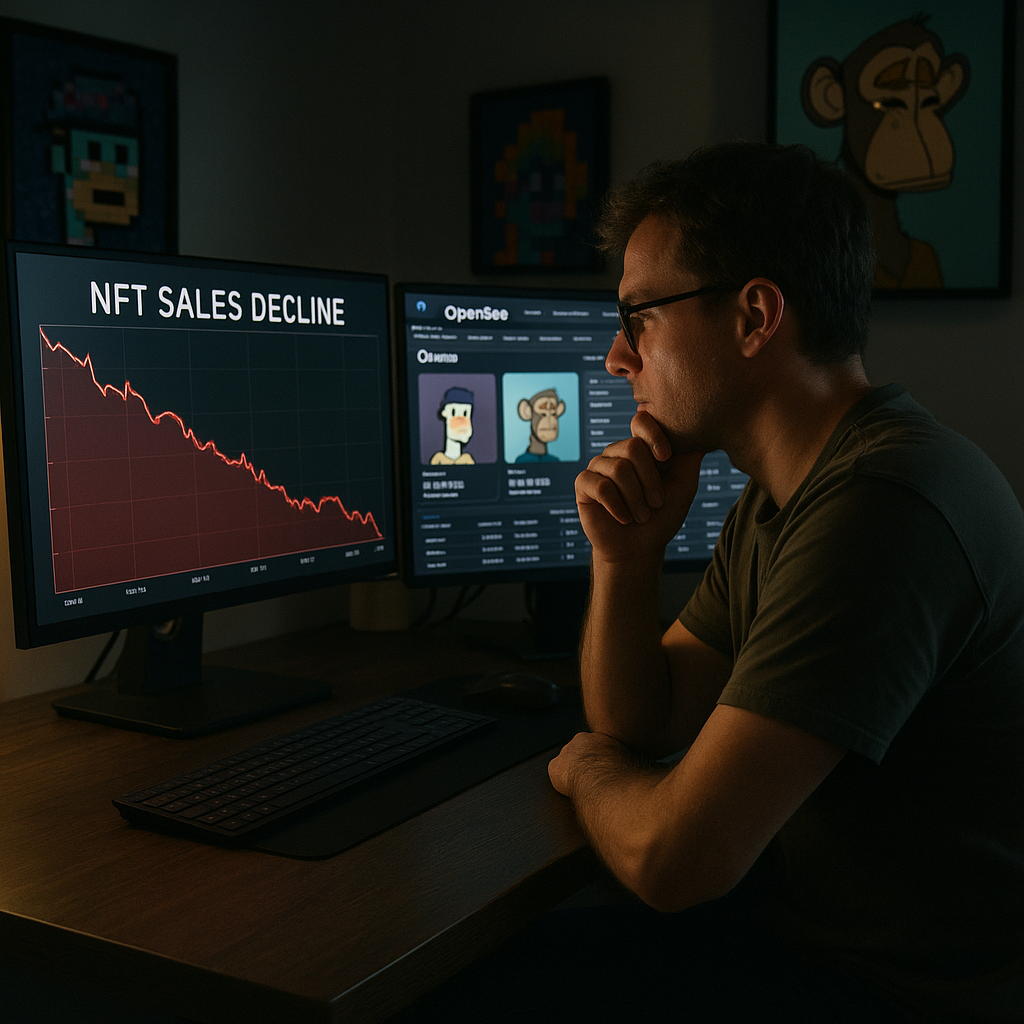NFT Sales Decline in April 2022 as Market Hype Cools
After a year of explosive growth, NFT sales volumes are showing clear signs of slowdown in April 2022. Weekly transactions, active wallets, and floor prices are all dipping, sparking debate over whether the NFT market is entering a correction or simply maturing.
As headlines fade and retail interest cools, questions arise: is the NFT hype cycle over — or is this just the next phase in a longer-term evolution?
NFT Market by the Numbers
According to data from NonFungible.com and DappRadar, April has seen notable declines in several key metrics:
-
Weekly NFT sales volume is down more than 50% from January peaks.
-
The number of active market participants has dropped significantly.
-
Average sale prices across major collections like Bored Ape Yacht Club (BAYC) and CryptoPunks are falling or flattening.
-
OpenSea, the largest NFT marketplace, saw its daily volume fall from over $200M in February to around $50–60M in early April.
While some new collections continue to launch, secondary market activity has cooled, and speculative flipping is less common.
Why Are NFT Sales Slowing?
Several factors are contributing to the current pullback in NFT momentum:
-
Market Saturation
Thousands of NFT projects launched in late 2021 and early 2022. Many failed to deliver value, leading to a dilution of demand and buyer fatigue. -
Speculation Fatigue
After months of “minting mania” and sky-high gas fees, casual investors are stepping back as profitability drops and attention shifts. -
Broader Market Conditions
Crypto markets are under pressure from rising interest rates, inflation fears, and macroeconomic uncertainty, reducing risk appetite across the board. -
Lower Media Coverage
With fewer record-breaking sales and celebrity drops, mainstream media attention has cooled — taking casual traffic with it. -
Liquidity Shift
Many traders are reallocating to other sectors like Layer 1 tokens, DeFi, or metaverse-related plays, leaving the NFT market with lower liquidity.
Are NFTs in a Bubble — or Just Normalizing?
Critics argue that the NFT market was never sustainable, citing the speculative nature of many collections and the lack of real utility behind most tokens.
However, defenders offer a different view:
-
All emerging technologies experience boom-and-bust cycles.
-
The slowdown allows the market to shake out low-quality projects.
-
Builders can now focus on long-term value creation instead of hype.
In other words, this may be a healthy correction, not a collapse.
What’s Still Working in NFTs?
Despite the slowdown, certain segments continue to show strength:
-
Blue-chip NFTs like BAYC and CloneX retain relatively high floors and active communities.
-
Gaming NFTs tied to platforms like Axie Infinity, Illuvium, and The Sandbox maintain use-based demand.
-
Music and utility NFTs are gaining traction, offering real-world benefits or token-gated experiences.
-
Enterprise adoption continues quietly, with brands like Nike, Adidas, and Starbucks building NFT strategies behind the scenes.
NFTs tied to identity, membership, and access may represent the next phase of growth — moving beyond simple JPEG ownership.
Key Market Trends in April 2022
Here are some of the notable patterns defining this transitional phase:
-
Floor price compression is forcing projects to differentiate or die.
-
Royalties and revenue models are being reevaluated as creators seek sustainability.
-
Community retention has become the new currency — hype alone no longer sells.
-
Gas efficiency and Layer 2 solutions (like Immutable X and Polygon) are gaining attention as Ethereum congestion remains an issue.
Collectors are becoming more selective, with deeper research into project roadmaps, utility, and team transparency.
Investor and Creator Strategy Going Forward
Whether you’re holding NFTs or planning to launch a project, this is a time for smart, cautious moves:
-
Avoid chasing hype drops
Momentum-based trades are risky in lower-liquidity environments. -
Focus on fundamentals
Projects with long-term plans, utility, and active communities are more likely to survive. -
Diversify exposure
Don’t overweight NFTs in a volatile portfolio — include tokens, stablecoins, or even real-world assets. -
Keep building
For creators, now is the time to improve storytelling, deliver roadmap promises, and engage genuinely. -
Use analytics tools
Track volume, wallet activity, and price movement using platforms like Nansen, Dune Analytics, or Icy.tools.
Is This the End of NFTs? Unlikely.
NFTs are evolving — not disappearing. What we’re seeing in April 2022 is a cooling of speculative energy, not a rejection of the underlying technology.
Major industries like art, gaming, identity, and ticketing are still exploring NFT integration. Meanwhile, infrastructure is improving rapidly, from wallet UX to scalability solutions.
Just as the dot-com bubble burst in 2000 but left behind giants like Amazon and Google, the NFT space may be weeding out excess to make room for sustainable players.
Conclusion: The NFT Market Catches Its Breath
After a year of relentless growth and eye-popping headlines, the NFT market is finally cooling off — and that might be a good thing. The April 2022 slowdown reflects a maturing space where utility, community, and innovation will replace raw speculation.
Whether this phase lasts weeks or months, one thing is clear: NFTs are not dead — they’re just entering their next chapter.
Smart investors and builders are already preparing for it.
